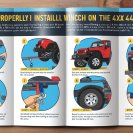Winching in Off-Roading: The Ultimate Recovery Tool
Winching in Off-Roading: The Ultimate Recovery Tool
Off-roading is a thrilling adventure that allows enthusiasts to explore rugged terrains and conquer challenging obstacles. However, even the most experienced off-roaders can find themselves in tricky situations where they need a little extra help. This is where winching comes in as a crucial tool for off-road recovery.
What is Winching?
Winching is the process of using a mechanical device, known as a winch, to pull a vehicle out of a difficult or stuck situation. It involves attaching a cable or synthetic rope to a fixed anchor point, such as a tree or rock, and then using the winch's motor to reel in the cable, exerting force to free the stuck vehicle.
Why is Winching Important in Off-Roading?
Off-roading often involves traversing challenging terrains like mud, sand, snow, or steep inclines. Inevitably, there will be instances where a vehicle becomes stuck or immobilized. This is where winching becomes crucial. It allows off-roaders to self-recover or assist others in getting their vehicles back on track, minimizing the need for external assistance.
Types of Winches:
1. Electric Winches: Electric winches are the most common type found in off-road vehicles. They are powered by the vehicle's battery and offer a reliable and efficient solution for recovery operations. Electric winches come in various sizes and capacities, allowing off-roaders to choose the one that suits their needs.
2. Hydraulic Winches: Hydraulic winches are powered by the vehicle's power steering pump or a separate hydraulic system. They provide a consistent pulling power even at low speeds, making them ideal for heavy-duty recovery operations. However, they are more complex to install and require additional maintenance.
Winching Techniques:
1. Self-Recovery: When a vehicle becomes stuck, off-roaders can use their winch to pull themselves out. It involves finding a suitable anchor point, attaching the winch cable securely, and slowly winding it in while maintaining a steady tension. Self-recovery requires careful planning and knowledge of the vehicle's capabilities and winching techniques.
2. Assisted Recovery: In situations where a vehicle cannot self-recover, winching can be used to assist another vehicle in recovery. This involves attaching the winch cable to the stuck vehicle and using the pulling force of the assisting vehicle to free it. Assisted recovery requires effective communication and coordination between the two vehicles.
Safety Considerations:
Winching can be dangerous if not done correctly. Here are some essential safety considerations:
1. Use proper equipment: Ensure that the winch, cables, and accessories are in good condition and suitable for the recovery operation.
2. Wear protective gear: Always wear gloves and eye protection when handling winching equipment to prevent injuries.
3. Secure anchor point: Verify the stability and strength of the anchor point before attaching the winch cable. Avoid using unstable objects or living trees as anchor points.
4. Use a snatch block: A snatch block can be used to change the direction of the winch cable, increasing the pulling capacity and reducing strain on the winch.
5. Maintain proper tension: Maintain a steady tension on the winch cable during the recovery process to prevent the cable from snapping or the vehicle from jerking suddenly.
6. Follow manufacturer's instructions: Read and understand the winch manufacturer's instructions and recommended guidelines for safe and effective winching.
Conclusion:
Winching is an essential tool for off-roaders, providing a reliable means of recovery in challenging situations. Whether it's self-recovery or assisting others, a winch can make a significant difference in getting a stuck vehicle back on the trail. However, it is crucial to prioritize safety and follow proper winching techniques to ensure a successful and accident-free recovery operation. So, before hitting the off-road trails, make sure to equip your vehicle with a reliable winch and gain the necessary knowledge and skills to use it effectively. Happy off-roading and safe recoveries!
Wyciągarki możesz zakupić w sklepie Szekla4x4.pl
Winching Accessories:
In addition to the winch itself, there are several accessories that can enhance the effectiveness and safety of winching operations:
1. Winch Line Dampener: A winch line dampener is a safety device that is placed over the winch cable or rope during recovery operations. It helps to absorb the energy in case of a cable failure, preventing it from whipping back and causing injuries.
2. Winch Extension Strap: Sometimes, the distance between the stuck vehicle and an available anchor point may be too far for the winch cable to reach. In such cases, a winch extension strap can be used to bridge the gap and extend the reach of the winch.
3. Snatch Blocks: A snatch block is a pulley-like device that can be used to change the direction of the winch cable. By using a snatch block, the pulling force can be redirected to provide a more effective and efficient recovery.
4. Tree Saver Strap: When using a tree as an anchor point, it is essential to protect the tree from damage caused by the winch cable. A tree saver strap is designed to wrap around the tree, providing a strong attachment point and preventing damage to the tree bark.
5. Recovery Gloves: Recovery gloves are heavy-duty gloves designed to protect the hands during winching operations. They provide extra grip and prevent cuts, abrasions, and blisters when handling the winch cable.
6. Winch Damper Blanket: A winch damper blanket is similar to a winch line dampener but is specifically designed to cover the winch drum. It helps to reduce the noise and vibration generated during winching and provides an extra layer of protection.
Winching Techniques:
1. Single-Line Pull: The most common winching technique is the single-line pull, where the winch cable is connected to the stuck vehicle and wound in to pull it out. This technique is suitable for most recovery situations and is straightforward to execute.
2. Double-Line Pull: In situations where a single-line pull does not provide enough pulling power, a double-line pull can be used. This technique involves using a snatch block to redirect the winch cable, effectively doubling the pulling power of the winch.
3. Angle Pull: When recovering a vehicle that is stuck at an angle or on a slope, an angle pull can be employed. This technique involves attaching the winch cable at an angle to the stuck vehicle, allowing for a more effective recovery.
4. Self-Anchor Pull: In situations where there are no available anchor points, a self-anchor pull can be used. This technique involves using the winch and a ground anchor or a deadman anchor to create a secure anchor point for the recovery.
5. Controlled Descent: Winches can also be used for controlled descents, allowing vehicles to safely navigate steep inclines or descents. By using the winch to control the speed and descent of the vehicle, off-roaders can maintain control and prevent accidents.
Conclusion:
Winching is an essential skill for off-roaders, providing a reliable means of recovery in challenging off-road situations. Along with the winch, using the right accessories and techniques can significantly enhance the effectiveness and safety of winching operations. It is crucial to invest in high-quality equipment, practice proper winching techniques, and prioritize safety at all times. With the right knowledge and tools, off-roaders can confidently tackle any obstacle and enjoy the thrill of off-roading while being prepared for any recovery situation that may arise.

Zobacz także

Jak prawidłowo zainstalować wyciągarkę w swoim pojeździe 4x4? Praktyczny poradnik
Jak prawidłowo zainstalować wyciągarkę w swoim pojeździe 4x4? Praktyczny poradnik Wyciągarka to jeden z...
Czytaj dalej
Oświetlenie dodatkowe do maszyn budowlanych - niezbędny element zapewniający bezpieczeństwo i wydajność na placu budowy
Oświetlenie dodatkowe do maszyn budowlanych - niezbędny element zapewniający bezpieczeństwo i wydajność na...
Czytaj dalej




